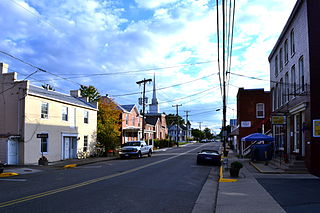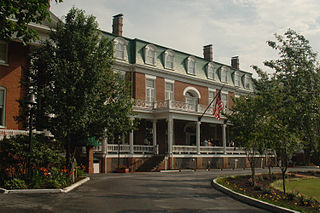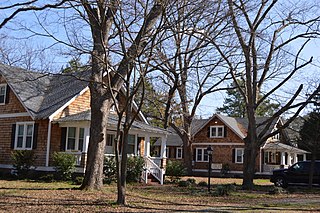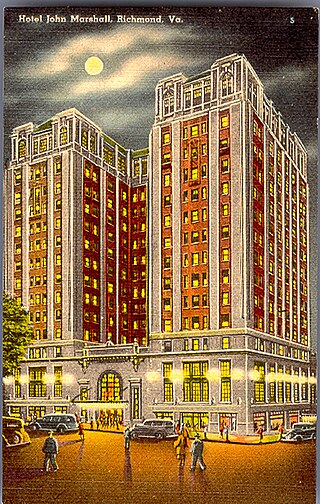
The Court House Hill–Downtown Historic District is a national historic district located in Lynchburg, Virginia. The area is situated on a promontory overlooking the Lower Basin Historic District on the south bank of the James River. The approximately 50-acre (200,000 m2) district is composed of relatively intact city blocks of religious, commercial, residential, and governmental buildings and structures ranging in date from the early 19th century to the mid-20th century. Buildings in the district represent a variety of styles from the different periods, including the Federal, Greek Revival, Gothic Revival, Italianate, Queen Anne, Neoclassical, Italian Renaissance, Spanish Eclectic, Craftsman, and Art Deco styles.

The Oakwood–Chimborazo Historic District is a national historic district of 434 acres (176 ha) located in Richmond, Virginia. It includes 1,284 contributing buildings, three contributing structures, five contributing objects and four contributing sites. It includes work by architect D. Wiley Anderson. The predominantly residential area contains a significant collection of late-19th and early-20th century, brick and frame dwellings that display an eclectic mixture of Late Victorian, Queen Anne, and Colonial Revival styles.

Madison County Courthouse Historic District is a national historic district located at Madison, Madison County, Virginia. The district encompasses 66 contributing buildings in the county seat of Madison. In addition to the separately listed Madison County Courthouse, there are a variety of residential, commercial, and institutional buildings dating from the early 19th to the 20th century. Notable buildings include the County Clerk's Office (1832), the Washington Tavern or Eagle House, the Arcade (1830s), Piedmont Episcopal Church (1832-1834), the Madison Presbyterian and Methodist churches (1852-1853), Hunton House Hotel, and the Linn Banks Masonic Lodge (1855).
Snowville Historic District is a national historic district located at Snowville, Pulaski County, Virginia. It encompasses 44 contributing buildings in the village of Snowville. It includes a variety of residential, commercial, and industrial buildings dated as early as the 1850s. Notable buildings include the Snowville Milling Complex (1856-1857), Elmore House, Snow-Bullard House, "Humility," Snowville school (1880s), Masonic temple (1865), Reese Blacksmith Shop, and the store and village post office. Located in the district is the separately listed Snowville Christian Church.

Sperryville Historic District is a national historic district located at Sperryville, Rappahannock County, Virginia, USA. It encompasses 63 contributing buildings in the village of Sperryville. The buildings are predominantly wood-frame, one-and two-story residences, some of which have been converted to commercial establishments. They include a collection of former factory workers' housing built to serve the workers of the Smoot tannery from 1867 to the early 20th century. A number of the buildings were constructed after 1850 with ornamentation and board-and-batten siding that is suggestive of the mid-century Romantic Revivals.

Bridgewater Historic District is a national historic district located at Bridgewater, Rockingham County, Virginia. The district encompasses 127 contributing buildings and 1 contributing site in the central business district and surrounding residential areas of the town of Bridgewater. It includes a variety of residential, commercial, and institutional buildings most of which date from the 19th century and early-20th century. Notable buildings include the Jacob Dinkle House, the St. Claire Kyle House, the J. G. Brown House, Dr. T. H. B. Brown House, the Hite House, Childress House, Whitmore House, the O. W. Miller House, Dr. Strickler House, Masonic Lodge, Methodist Church (1841), Baptist Church, Farmer's Bank, Berlin Building (1883), Geary Building (1887), and the Lutheran Church (1881). Also included is the oldest portion of the Bridgewater College campus, consisting of five fine brick collegiate buildings constructed before 1911.

Dayton Historic District is a national historic district located at Dayton, Rockingham County, Virginia, USA. The district encompasses 154 contributing buildings and one contributing site in the central business district and surrounding residential areas of the town of Dayton. It includes a variety of residential, commercial, and institutional buildings most of which date from the late-19th century and early-20th century. Notable buildings include the Alberta Coffman House, Layman House, the Samuel Shrum House, the Thomas House, W.J. Franklin House, Bank of Dayton (1911), the Ruebush-Kieffer Printing Company, Dayton Drug Company, Howe Memorial Hall, the Administration Building (1910), the Kieffer Alumni Gymnasium (1930), Carpenter Store (1888), Specialty Harness Company, Ruebush-Kieffer Company, and the Methodist, Presbyterian, and United Brethren churches.

Spotsylvania Court House Historic District is a national historic district located at Spotsylvania, Spotsylvania County, Virginia. The district includes 24 contributing buildings in the historic core of Spotsylvania. The principal building is the Spotsylvania Court House, a two-story Roman Revival style brick building built in 1839-1840 and extensively remodeled in 1901. The front facade features a tetrastyle portico in the Tuscan order. Associated with the courthouse is a late 18th-century jail and office and storage buildings erected in the 1930s. Other notable buildings include the Spottswood Inn, Berea Church (1856), Christ Church (1841), Dabney Farm, J.P.H. Crismond House, Harris House, and Cary Crismond House.

Abingdon Historic District is a national historic district located at Abingdon, Washington County, Virginia. The district encompasses 145 contributing buildings, 2 contributing site, and 13 contributing structures in the town of Abingdon. It includes a variety of residential, commercial, and institutional buildings dating from the late-18th century to the mid-20th century. Notable contributing resources include Sinking Spring Cemetery, William King High School (1913), General Francis Preston House (1832), Martha Washington Inn, Barter Theatre, the Virginia House, Alexander Findlay House (1827), Gabriel Stickley House, Ann Berry House, Washington County Courthouse (1868), Rev. Charles Cummings House, and James Fields House (1857). Located in the district and separately listed are the Abingdon Bank and Dr. William H. Pitts House.

Kinsale Historic District is a national historic district located at Kinsale, Westmoreland County, Virginia. The district encompasses 65 contributing buildings in the historic core of the village of Kinsale. The district includes primarily residential and commercial buildings dating from the late-19th to early-20th centuries. Notable resources include the Bailey Cemetery, the Great House and Little House, Plain View, Captain Charles Courtney House, former Bank of Kinsale, former Palmer and Moore Kinsale Motor Corporation, Cople District Volunteer Fire Hall Department Building, Kinsale Foundation and Museum, and Kinsale Harbour Yacht Club.

Charlottesville and Albemarle County Courthouse Historic District, also known as the Charlottesville Historic District is a national historic district located at Charlottesville, Virginia. The district encompasses the previously listed Albemarle County Courthouse Historic District and includes 269 contributing buildings and 1 contributing object in the city of Charlottesville. It includes the traditional heart of the city's commercial, civic, and religious activities, with early residential development and industrial sites located along the fringe. The commercial core is located along a seven block Downtown Mall designed by Lawrence Halprin (1916-2009). Notable buildings include the Albemarle County Courthouse, Levy Opera House, Number Nothing, Redland Club, Eagle Tavern, United States Post Office and Courts Building (1906), Christ (Episcopal) Church (1895-1898), Beth Israel Synagogue (1882-1903), Holy Comforter Catholic Church (1925), First Methodist Church (1924), McIntire Public Library (1919-1922), and Virginia National Bank (1916). Also located in the district are the separately listed Abell-Gleason House, William H. McGuffey Primary School, Thomas Jonathan Jackson sculpture, Robert Edward Lee sculpture, and Marshall-Rucker-Smith House.

Oaklette Historic District is a national historic district located at Chesapeake, Virginia. The district encompasses 30 contributing buildings and 1 contributing object in an early-20th century planned streetcar suburb of Norfolk, Virginia. It is a primarily residential district that developed starting about World War I. The dwellings include representative examples of the Colonial Revival and Bungalow styles. Notable buildings include the Savage House (1915-1919), Pascal Paxson House (1901), George Wesley Jones House (1925), Samuel Paxson House (1906), Colonna Estate Caretaker's House (1925), and the Baker House (1910).
North End Historic District is a national historic district located at Newport News, Virginia. It encompasses 451 contributing buildings in a primarily residential section of Newport News. It is a compact, middle-class and upper middle-class residential neighborhood that arose during the period 1900–1935 in association with the nearby Newport News Shipbuilding and Dry Dock Company. The neighborhood includes notable examples of the Victorian, Colonial Revival, and Bungalow styles. Notable buildings include the Walter A. Post House (1902), John Livesay House (1906), J. E. Warren House (1905), W. L. Shumate House (1915), and Willet House.

The West Freemason Street Area Historic District is a national historic district located at Norfolk, Virginia. It encompasses 48 contributing buildings in a primarily residential section on the western edge of the center city of Norfolk. It developed between the late-18th and early-20th centuries and includes notable examples of the Federal, Greek Revival, and Late Victorian styles. Notable buildings include Kenmure House Glisson House, Whittle House, McCullough Row, and the Camp-Hubard house. Located in the district is the separately listed Allmand-Archer House.

Petersburg Old Town Historic District is a national historic district located at Petersburg, Virginia. The district includes 174 contributing buildings located in the oldest section of Petersburg. It includes a varied collection of late 18th- through 20th-century architecture. Notable buildings include the Strachan-Harrison house, the John F. May house, South Side Railroad Depot, High Street United Methodist Church, Church of Christ (1925), and the Powell Manufacturing Co. Located in the district and separately listed are the Appomattox Iron Works, City Market, Exchange Building, Farmers' Bank and Nathaniel Friend House.

Centre Hill Historic District is a national historic district located at Petersburg, Virginia. The district includes 81 contributing buildings located in a predominantly residential section of Petersburg. It includes a varied collection of early-19th-century to early-20th century houses and includes notable examples of Greek Revival, Italianate, Colonial Revival, and Bungalow style architecture. Notable buildings include the Centre Hill Apartment Building (1915), Eichberg House, Powell House, Unger House, and St. Joseph's Convent. Located in the district and separately listed is the Centre Hill Museum.

The West Franklin Street Historic District is a national historic district located at Richmond, Virginia. It is located along the northern boundary of the Fan district. The district encompasses 71 contributing buildings built between about 1870 and the 1920. It was originally developed as a primarily residential district with buildings in a variety of popular late-19th and early-20th century architectural styles including Greek Revival, Romanesque, Georgian Revival, Queen Anne, and Italianate. Many of the dwellings have been converted to commercial use. In addition, the district's private houses have been converted into multi-family housing and departmental offices for Virginia Commonwealth University. Notable buildings include Franklin Terrace, the Ritter-Hickock House, First Independent Church, Founder's Hall, the Raleigh Building, The Greyston Apartments, Gresham Court Apartments, and the Beth Ahabah Congregation Hall and Synagogue.

The Grace Street Commercial Historic District is a national historic district located in Richmond, Virginia. The district encompasses 93 contributing buildings located in downtown Richmond. The buildings reflect the core of the city's early 20th-century retail development and the remnants of a 19th-century residential neighborhood. The buildings are in a variety of popular 19th-century and early 20th-century architectural styles, including Classical Revival, Mission Revival, International Style, and Colonial Revival. Notable buildings include the Administration and Equipment Building for the Chesapeake & Potomac Telephone Company (1929), Thalhimer's Department Store, Atlantic Life Building (1950-1959), Miller & Rhoads Department Store, Berry-Burk Building, former W. W. Foster Studios (1927), Bank of Virginia (1949), Investment Realty Company building (1930), W.T. Grant Store (1939), Hotel John Marshall (1927), Franklin Federal Savings and Loan building (1954), and the Tompkins House (1820). Located in the district and separately listed are the Loew's Theatre, Centenary United Methodist Church, Joseph P. Winston House, Central National Bank, and National Theater.

The Laburnum Park Historic District is a national historic district located at Richmond, Virginia. The district encompasses 226 contributing buildings and 2 contributing structures located north of downtown Richmond. The primarily residential area developed starting in the early-20th century as one of the city's early "streetcar suburbs" and as home to several important local institutions. The buildings are in a variety of popular early-20th century architectural styles including Queen Anne and Colonial Revival. It was developed as neighborhood of middle-to-upper-class, single-family dwellings. Notable buildings include the Laburnum House (1908), Richmond Memorial Hospital (1954–1957), Richmond Memorial Hospital Nursing School (1960–1961), "The Hermitage" (1911), Laburnum Court (1919), Veritas School.

Newtown Historic District is a national historic district located at Staunton, Virginia. The district encompasses 414 contributing buildings and 2 contributing sites in a primarily residential section of Staunton. The district includes some late 18th- and early 19th-century structures, but most of the homes were built between 1870 and 1920 during Staunton's boom years. The buildings range from Jeffersonian Neo-Classical and Greek Revival to bungalows of the 1920s. Notable buildings include Stuart Hall's Cochran House (1858), Robertson House (1886), the Smith Thompson House, and the George M. Cochran House. The magnificent grounds of Thornrose Cemetery are also included in the district. Located in the district are the separately listed Stuart Hall School, Stuart House, and Trinity Episcopal Church.






















